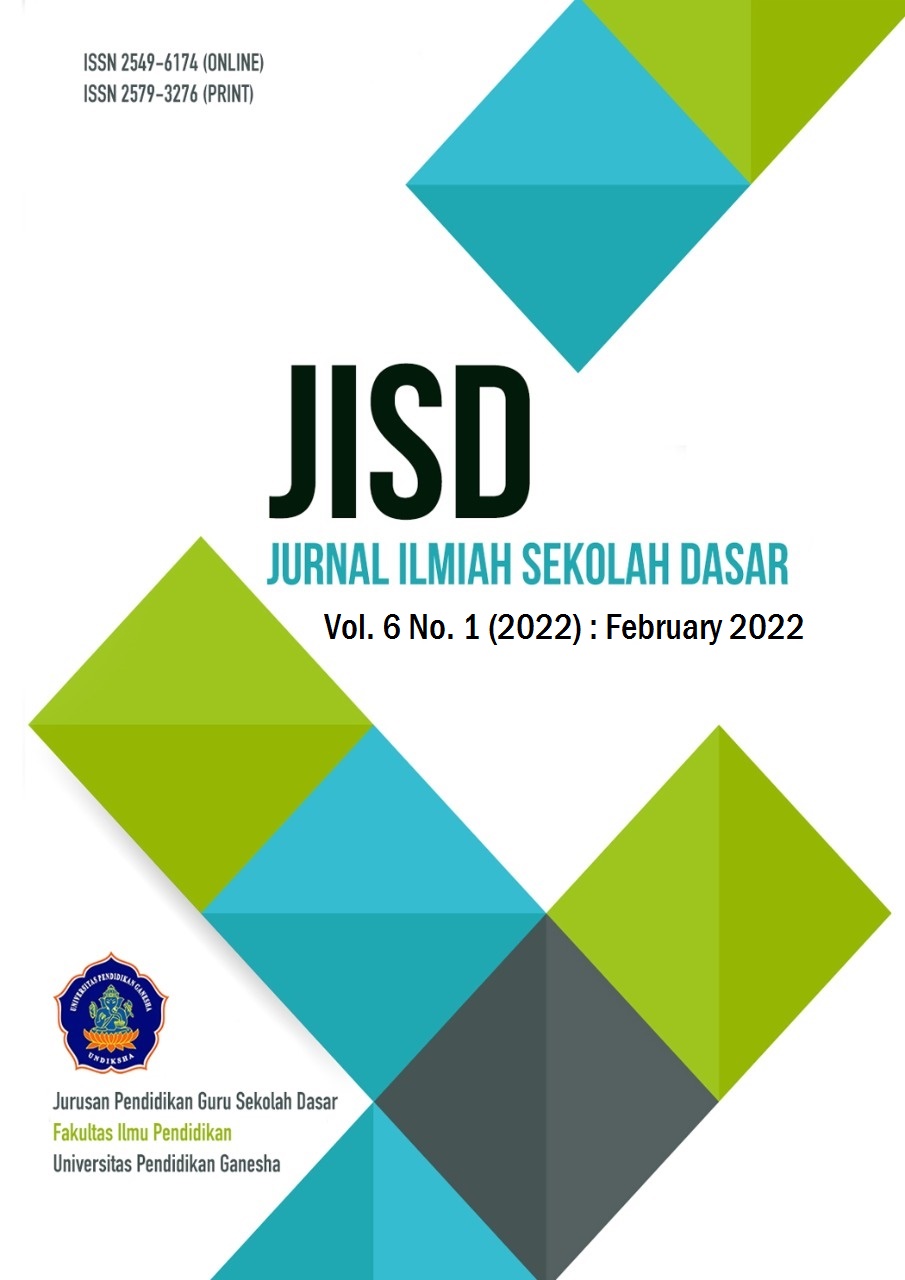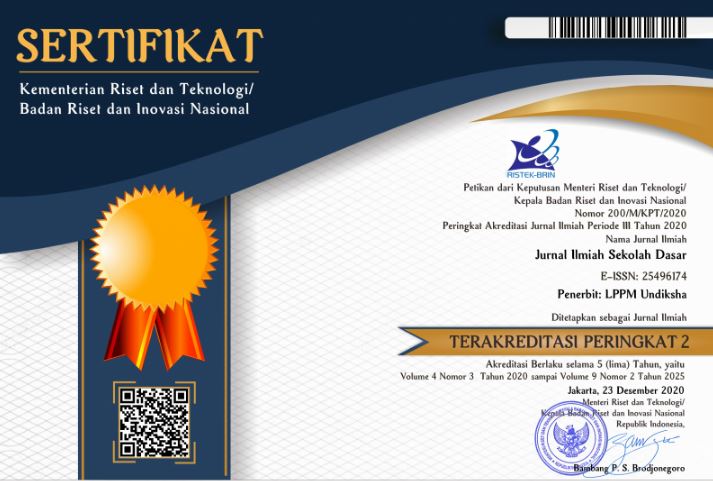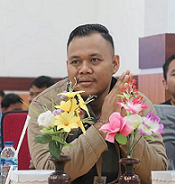Student Gestures in Solving Mathematics Problems in Group Discussion Activities
DOI:
https://doi.org/10.23887/jisd.v6i1.41863Keywords:
Gesture, Problem Solving, MathematicsAbstract
As one of the subjects in the national education curriculum, mathematics has an important role in human life. Mathematics is not only used as a reference for continuing higher education but is also used to support one's career. However, in reality, students still find it difficult to understand the material being studied, including understanding the problems in mathematics. This study aims to analyze the use of gestures in solving mathematical problems in group discussions. This research uses qualitative research and uses exploratory, descriptive research. The research subjects selected consisted of 2 students in the low group, two in the medium group, and two in the high group based on discussions with the subject teacher. The observed gesture is when students solve problems in groups. The results of data analysis show that the gestures made by students have several variations. Students in the high group performed more gestures such as pointing, writing, and representational gestures, and they understood the problem better. Representational gestures used by high-ability students can provide conceptual understanding to their groupmates, while those with moderate and low abilities in the discussion process of solving mathematical problems are still confused in representing the intent of their problem-s.
References
Alibali, M. W., & Nathan, M. J. (2011). Embodiment in Mathematics Teaching and Learning: Evidence from Learner’s and Teacher’s Gestures. The Journal of the Learning Sciences. https://doi.org/10.1080/10508406.2011.611446. DOI: https://doi.org/10.1080/10508406.2011.611446
Ambussaidi, I., & Yang, Y.-F. (2019). The Impact of Mathematics Teacher Quality on Student Achievement in Oman and Taiwan. International Journal of Education and Learning, 1(2), 50–62. https://doi.org/10.31763/ijele.v1i2.39. DOI: https://doi.org/10.31763/ijele.v1i2.39
Anggreni, Wiarta, & Putra. (2020). Pengaruh Model Pembelajaran ( SAVI ) Berbasis ( TIK ) Terhadap Kompetensi Pengetahuan Matematika. Pedagogi Dan Pembelajaran, 3(1), 15–24. https://doi.org/10.23887/jp2.v3i1.24357. DOI: https://doi.org/10.23887/jp2.v3i1.24357
Ashwin, & Guddeti, R. M. R. (2020). Affective database for e-learning and classroom environments using Indian students’ faces, hand gestures and body postures. Future Generation Computer Systems, 108. https://doi.org/10.1016/j.future.2020.02.075. DOI: https://doi.org/10.1016/j.future.2020.02.075
Baswendro, S., Suyitno, A., & Kharis, M. (2015). Keefektifan Model Tgt Dengan Pendekatan Scientific Berbantuan Cd Pembelajaran Terhadap Kemampuan Pemecahan Masalah Siswa Smp Kelas VIII Pada Materi Lingkaran. Unnes Journal of Mathematics Education, 4(3). https://doi.org/10.15294/ujme.v4i3.9043.
Becvar, A., Hollan, J., & Hutchins, E. (2008). Representational Gestures as Cognitive Artifacts for Developing Theories in a Scientific Laboratory. Spinger. DOI: https://doi.org/10.1007/978-1-84628-901-9_5
Burkhardt-Reed, M. M., Long, H. L., Bowman, D. D., Bene, E. R., & Oller, D. K. (2021). The origin of language and relative roles of voice and gesture in early communication developmen. Infant Behavior and Development, 65. https://doi.org/10.1016/j.infbeh.2021.101648. DOI: https://doi.org/10.1016/j.infbeh.2021.101648
Chabibah, L. N., Siswanah, E., & Tsani, D. F. (2019). Analisis Kemampuan Pemecahan Masalah Siswa dalam Menyelesaikan Soal Cerita Barisan Ditinjau dari Adversity Quotient. Pythagoras: Jurnal Pendidikan Matematika, 14(2), 199–210. https://doi.org/10.21831/pg.v14i2.29024. DOI: https://doi.org/10.21831/pg.v14i2.29024
Closser, A. H., Erickson, J. A., Smith, H., Varatharaj, A., & Botelho, A. F. (2021). Blending learning analytics and embodied design to model students’ comprehension of measurement using their actions, speech, and gestures. International Journal of Child-Computer Interaction. https://doi.org/10.1016/j.ijcci.2021.100391. DOI: https://doi.org/10.1016/j.ijcci.2021.100391
Costini, O., Roy, A., Remigereau, C., Faure, S., Fossoud, C., & Gall, D. Le. (2017). Nature and Specificity of Gestural Disorder in Children with Developmental Coordination Disorder: A Multiple Case Study. Frontiers in Psychology, 8. https://doi.org/10.3389/fpsyg.2017.00995. DOI: https://doi.org/10.3389/fpsyg.2017.00995
Creswell, J. W. (2012). Educational Research : Planning, Conducting, and Evaluating Quantitatine and Qualitative Research (4th ed.). Pearson Education, Inc.
Dargue, N., Sweller, N., & Carter, M. (2021). Short report: Learning through iconic gesture in autism spectrum disorder. Research in Developmental Disabilities, 115. https://doi.org/10.1016/j.ridd.2021.104000. DOI: https://doi.org/10.1016/j.ridd.2021.104000
Dubé, A. K., & McEwen, R. N. (2015). Do gestures matter? The implications of using touchscreen devices in mathematics instruction. Learning and Instruction, 40. https://doi.org/10.1016/j.learninstruc.2015.09.002. DOI: https://doi.org/10.1016/j.learninstruc.2015.09.002
Fitriyah, F., Murtadlo, A., & Warti, R. (2017). Pengaruh Model Pembelajaran Discovery Learning terhadap Hasil Belajar Matematika Siswa MAN Model Kota Jambi. Jurnal Pelangi, 9(2), 108–112. https://doi.org/10.22202/jp.2017.v9i2.1898. DOI: https://doi.org/10.22202/jp.2017.v9i2.1898
Flood, V. J. (2021). The secret multimodal life of IREs: Looking more closely at representational gestures in a familiar questioning sequence. Linguistics and Education, 63. https://doi.org/10.1016/j.linged.2021.100913. DOI: https://doi.org/10.1016/j.linged.2021.100913
Fonger, N. L. (2019). Meaningfulness in representational fluency: An analytic lens for students’ creations, interpretations, and connections. The Journal of Mathematical Behavior, 54. https://doi.org/10.1016/j.jmathb.2018.10.003. DOI: https://doi.org/10.1016/j.jmathb.2018.10.003
Francaviglia, M., & Servidio, R. (2011). Gesture as a Cognitive Support to Solve Mathematical Problems. American Psychology Assosiation, 2(2). https://doi.org/10.4236/psych.2011.22015. DOI: https://doi.org/10.4236/psych.2011.22015
Freitas, & Sinclair. (2012). Diagram, gesture, agency: theorizing embodiment in the mathematics classroom. Educational Studies in Mathematics, 80. https://doi.org/10.1007/s10649-011-9364-8. DOI: https://doi.org/10.1007/s10649-011-9364-8
Hasibuan, H. Y., Syamsuri, S., Santosa, C. A. H. F., & Pamungkas, A. S. (2020). Profil Pembelajaran Matematika pada Anak Berkebutuhan Khusus Ragam Slow Learner di Kelas Inklusif SMP Garuda Cendekia Jakarta. Journal Of Medives: Journal Of Mathematics Education Ikip Veteran Semarang., 4(1). https://doi.org/10.31331/medivesveteran.v4i1.993. DOI: https://doi.org/10.31331/medivesveteran.v4i1.993
Herbert, S., & Pierce, R. (2013). Gesture as data for a phenomenographic analysis of mathematical conceptions. International Journal of Educational Research, 60. https://doi.org/10.1016/j.ijer.2013.03.004. DOI: https://doi.org/10.1016/j.ijer.2013.03.004
Hidayat, W., & Sariningsih, R. (2018). Kemampuan Pemecahan Masalah Matematis dan Adversity Quotient Siswa SMP Melalui Pembelajaran Open Ended. Jurnal Nasional Pendidikan Nasional, 2(1), 109–118. https://doi.org/10.33603/jnpm.v2i1.1027. DOI: https://doi.org/10.33603/jnpm.v2i1.1027
Hobri, Adeliyanti, S., Fatekurrahman, M., Wijaya, H. T., Oktavianingtyas, E., Putri, I. W. S., & Ridlo, Z. R. (2021). E-Comic Mathematics Based on STEAM-CC and its Effect on Students Creative Thinking Ability. Journal of Physics: Conference Series, 1839(1). https://doi.org/10.1088/1742-6596/1839/1/012036. DOI: https://doi.org/10.1088/1742-6596/1839/1/012036
Keene, K. A., Stephan, M., & Rasmussen, C. (2012). Gestures and a chain of signification: the case of equilibrium solutions. Mathematics Education Research Journal, 24(3). https://doi.org/10.1007/s13394-012-0054-3. DOI: https://doi.org/10.1007/s13394-012-0054-3
Khairunnisa, G. F., & Ilmi, Y. I. N. (2020). Media Pembelajaran Matematika Konkret Versus Digital: Systematic Literature Review di Era Revolusi Industri 4.0. Jurnal Tadris Matematika, 3(2). https://doi.org/10.21274/jtm.2020.3.2.131-140. DOI: https://doi.org/10.21274/jtm.2020.3.2.131-140
Kurnia, V. T., Damayani, A. T., & Kiswoyo, K. (2019). Keefektifan Model Pembelajaran Number Head Together (NHT) Berbantu Media Puzzle Terhadap Hasil Belajar Matematika. Jurnal Ilmiah Sekolah Dasar, 3(2), 192. https://doi.org/10.23887/jisd.v3i2.17772. DOI: https://doi.org/10.23887/jisd.v3i2.17772
Lin, S., Zhou, Y., & Wijaya, T. T. (2020). Using hawgent dynamic mathematics software in teaching arithmetic operation. International Journal of Education and Learning, 2(1), 25–31. https://doi.org/10.31763/ijele.v2i1.97. DOI: https://doi.org/10.31763/ijele.v2i1.97
Majlesi, A. R. (2015). Matching gestures – Teachers’ repetitions of students’ gestures in second language learning classrooms. Journal of Pragmatics, 76. https://doi.org/10.1016/j.pragma.2014.11.006. DOI: https://doi.org/10.1016/j.pragma.2014.11.006
Nathalia, K. I., Sedanayasa, G., & Japa. (2015). Pengaruh Model Pembelajaran Berbasis Proyek Terhadap Hasil Belajar Matematika Ditinjau Dari Kemampuan Penalaran Operasional Konkret. Mimbar PGSD, 3(1). https://doi.org/10.23887/jjpgsd.v3i1.5656.
Nenotaek, B., Sujadi, I., & Subanti, S. (2019). The Difficulties in Implementing Scientific Approach for Mathematics Learning. International Journal of Educational Research Review. https://doi.org/10.24331/ijere.628448. DOI: https://doi.org/10.24331/ijere.628448
Okumus, S., & Hollebrands, K. (2019). Middle school students’ employments of gestures for forming three-dimensional objects using an extrusion or spinning method. The Journal of Mathematical Behavior, 56. https://doi.org/10.1016/j.jmathb.2019.100737. DOI: https://doi.org/10.1016/j.jmathb.2019.100737
Parrill, F., McKim, A., & Grogan, K. (2019). Gesturing standard deviation: Gestures undergraduate students use in describing their concepts of standard deviation. The Journal of Mathematical Behavior, 53. https://doi.org/10.1016/j.jmathb.2018.05.003. DOI: https://doi.org/10.1016/j.jmathb.2018.05.003
Pier, E. L., Walkington, C., Clinton, V., Boncoddo, R., Williams-Pierce, C., & Alibali, M. W. (2019). Embodied truths: How dynamic gestures and speech contribute to mathematical proof practices. Contemporary Educational Psychology, 58. https://doi.org/10.1016/j.cedpsych.2019.01.012. DOI: https://doi.org/10.1016/j.cedpsych.2019.01.012
Pucangan, A. A. S. N. A., Handayanto, S. K., & Wisodo, H. (2018). Pengaruh Scaffolding Konseptual dalam Problem Based Learning terhadap Kemampuan Pemecahan Masalah. Jurnal Pendidikan: Teori, Penelitian, Dan Pengembangan, 3(10), 1314–1318. https://doi.org/10.17977/jptpp.v3i10.11661.
Putri, M. R., As’ari, A. R., & Sisworo, S. (2020). Gesture Mahasiswa dalam Menyelesaikan Masalah Kombinatorika dengan Jawaban Benar Berdasarkan Tahap Berpikir Mason. Jurnal Pendidikan: Teori, Penelitian, Dan Pengembangan, 5(8). https://doi.org/10.17977/jptpp.v5i8.13962. DOI: https://doi.org/10.17977/jptpp.v5i8.13962
Safithri, R., Syaiful, S., & Huda, N. (2021). Pengaruh Penerapan Problem Based Learning (PBL) dan Project Based Learning (PjBL) Terhadap Kemampuan Pemecahan Masalah Berdasarkan Self Efficacy Siswa. Jurnal Cendekia : Jurnal Pendidikan Matematika, 5(1), 335–346. https://doi.org/10.31004/cendekia.v5i1.539. DOI: https://doi.org/10.31004/cendekia.v5i1.539
Setiawan, Y. (2020). Pengembangan Model Pembelajaran Matematika SD Berbasis Permainan Tradisional Indonesia dan Pendekatan Matematika Realistik. Scholaria: Jurnal Pendidikan Dan Kebudayaan, 10(1), 12–21. https://doi.org/10.24246/j.js.2020.v10.i1.p12-21. DOI: https://doi.org/10.24246/j.js.2020.v10.i1.p12-21
Setiyani, S., Fitriyani, N., & Sagita, L. (2020). Improving student’s mathematical problem solving skills through Quizizz. JRAMathEdu (Journal of Research and Advances in Mathematics Education), 5(3), 276–288. https://doi.org/10.23917/jramathedu.v5i3.10696. DOI: https://doi.org/10.23917/jramathedu.v5i3.10696
Shein, P. P. (2012). Seeing With Two Eyes: A Teacher’s Use of Gestures in Questioning and Revoicing to Engage English Language Learners in the Repair of Mathematical Errors. Journal for Research in Mathematics Education, 2(43). https://doi.org/10.5951/jresematheduc.43.2.0182. DOI: https://doi.org/10.5951/jresematheduc.43.2.0182
Taqiyyah, S. A., Subali, B., & Handayani, L. (2017). Implementasi Bahan Ajar Sains Berbahasa Inggris Berbasis Metakognitif Untuk Meningkatkan Kemampuan Pemecahan Masalah Siswa SMP. Jurnal Inovasi Pendidikan IPA, 3(2), 224–234. https://doi.org/10.21831/jipi.v3i2.14859. DOI: https://doi.org/10.21831/jipi.v3i2.14859
Tere, T., Bayu Seta, H., Nizar Hidayanto, A., & Abidin, Z. (2020). Variables Affecting E-Learning Services Quality in Indonesian Higher Education: Students’ Perspectives. Journal of Information Technology Education: Research, 19, 259–286. https://doi.org/10.28945/4489. DOI: https://doi.org/10.28945/4489
Ujianti, C. (2019). Penerapan Model Pembelajaran Kooperatif Tipe TAI (Team Assisted Individualization) untuk Meningkatkan Hasil Belajar Siswa pada Mata Pelajaran Matematika. Jurnal Cakrawala Pendas, 4(1), 1–14. https://doi.org/10.1017/CBO9781107415324.004. DOI: https://doi.org/10.31949/jcp.v4i1.707
Utomo, K. D., Soegeng, A. Y., Purnamasari, I., & Amaruddin, H. (2021). Pemecahan Masalah Kesulitan Belajar Siswa pada Masa Pandemi Covid-19. Mimbar PGSD Undiksha, 9(1), 1–9. https://doi.org/10.23887/jjpgsd.v9i1.29923. DOI: https://doi.org/10.23887/jjpgsd.v9i1.29923
Vivitri, M., & Sunardi, S. (2018). Peningkatan Hasil Belajar dengan Mengoptimalkan Metode Ekspositori Pada Mata Pelajaran Matematika Kelas VIII SMP. Jurnal Pendidikan Matematika RAFA, 4(2), 152–163. https://doi.org/10.19109/jpmrafa.v4i2.2898. DOI: https://doi.org/10.19109/jpmrafa.v4i2.2898
Walkington, C., Chelule, G., Woods, D., & Nathan, M. J. (2019). Collaborative gesture as a case of extended mathematical cognition. The Journal of Mathematical Behavior, 55. https://doi.org/10.1016/j.jmathb.2018.12.002. DOI: https://doi.org/10.1016/j.jmathb.2018.12.002
Walkington, C., Woods, D., Nathan, M. J., Chelule, G., & Wang, M. (2019). Does restricting hand gestures impair mathematical reasoning? Learning and Instruction, 64. https://doi.org/10.1016/j.learninstruc.2019.101225. DOI: https://doi.org/10.1016/j.learninstruc.2019.101225
Wardani, K. W., & Setyadi, D. (2020). Pengembangan Media Pembelajaran Matematika Berbasis Macromedia Flash Materi Luas dan Keliling untuk Meningkatkan Motivasi Belajar Siswa. Scholaria: Jurnal Pendidikan Dan Kebudayaan, 10(1), 73–84. https://doi.org/10.24246/j.js.2020.v10.i1.p73-84. DOI: https://doi.org/10.24246/j.js.2020.v10.i1.p73-84
Widiasih, L. S. (2019). Pengaruh Model Pembelajaran SFAE Berbasis Tri Kaya Parisudha terhadap Hasil Belajar Matematika Siswa. Jurnal Ilmiah Sekolah Dasar, 3(2). https://doi.org/10.23887/jisd.v3i2.17758. DOI: https://doi.org/10.23887/jisd.v3i2.17758
Winata, R., & Friantini, R. N. (2018). Proses Pemecahan Masalah Mahasiswa Pendidikan Matematika STKIP Pamane Talino. FIBONACCI: Jurnal Pendidikan Matematika Dan Matematika, 4(1), 87–96. https://doi.org/10.24853/fbc.4.1.87-96. DOI: https://doi.org/10.24853/fbc.4.1.87-96
Wulandari, & Agustika. (2018). Pengaruh Gaya Kognitif Terhadap Hasil Belajar Matematika Pada Mahasiswa Semester IV Jurusan PGSD UPP Denpasar Universitas Pendidikan Ganesha Tahun Ajaran 2016/2017. Jurnal Ilmiah Sekolah Dasar, 2(1). https://doi.org/10.23887/jisd.v2i1.15515. DOI: https://doi.org/10.23887/jisd.v2i1.15515
Yemi, T. M. (2018). Mastery Learning Approach (MLA): Its Effects On The Students Mathematics Academic Achievement. European Journal of Alternative Education Studies, 3(1). https://doi.org/10.46827/ejae.v0i0.1584.
Yuniawardani, V., & Mawardi. (2018). Peningkatan Hasil Belajar Pada Pembelajaran Matematika Dengan Model Problem Based Learning Kelas IV SD. Jurnal Riset Teknologi Dan Inovasi Pendidikan, 1(2), 24–32. https://doi.org/10.31764/justek.v1i1.416. DOI: https://doi.org/10.31764/justek.v1i1.416
Zuhaida, A. (2018). Program Sciences Kids Community Berbasis Group Investigation untuk Meningkatkan Kemampuan Pemecahan Masalah Madrasah Ibtidaiyah. Jurnal Pendidikan Sains (JPS), 6(2), 13–20. https://doi.org/10.26714/jps.6.2.2018.13-20. DOI: https://doi.org/10.26714/jps.6.2.2018.13-20
Downloads
Published
How to Cite
Issue
Section
License
Copyright (c) 2022 Masniladevi

This work is licensed under a Creative Commons Attribution-ShareAlike 4.0 International License.
Authors who publish with the Journal Ilmiah Sekolah Dasar agree to the following terms:
- Authors retain copyright and grant the journal the right of first publication with the work simultaneously licensed under a Creative Commons Attribution License (CC BY-SA 4.0) that allows others to share the work with an acknowledgment of the work's authorship and initial publication in this journal.
- Authors are able to enter into separate, additional contractual arrangements for the non-exclusive distribution of the journal's published version of the work (e.g., post it to an institutional repository or publish it in a book), with an acknowledgment of its initial publication in this journal.
- Authors are permitted and encouraged to post their work online (e.g., in institutional repositories or on their website) prior to and during the submission process, as it can lead to productive exchanges, as well as earlier and greater citation of published work. (See The Effect of Open Access)










